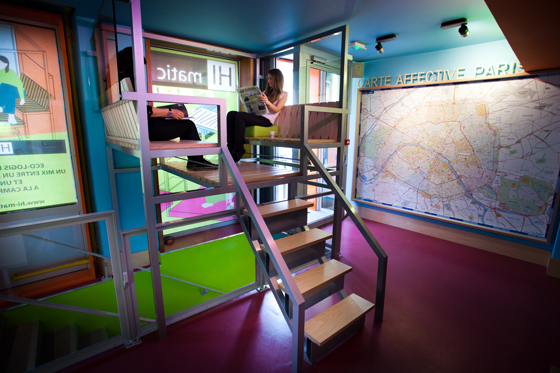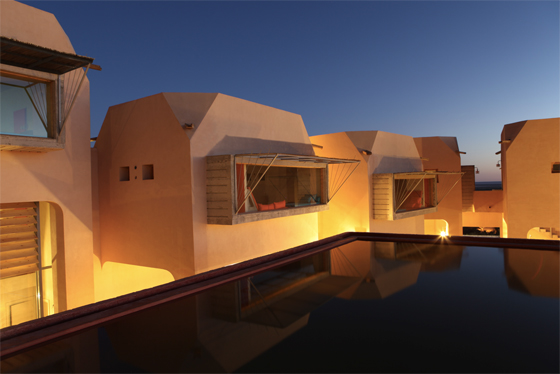The In-Betweener: matali crasset
Texte par Simon Keane-Cowell
Zürich, Suisse
24.06.11
She may elect to spell her name all lower case, but matali crasset's work is big on concept and ambition. Yet, the Paris-based designer, who's collaborated with the likes of Established & Sons and Pallucco, insists she's not that interested in products in themselves. Une contradiction? Pas du tout. Architonic invites you to read on to find out why.
matali crasset: 'I like to propose scenarios for living. I don't care about products or about space in themselves. Products and space have the potential to bring relief in life. That's why I'm a designer'; photo Benjamin Chelly

matali crasset: 'I like to propose scenarios for living. I don't care about products or about space in themselves. Products and space have the potential to bring relief in life. That's why I'm a designer'; photo Benjamin Chelly
×'I don't care about products.'
It's not every day you hear a designer say this. But, then again, matali crasset isn't your everyday designer. Designing for, as she puts it, 'the curious person', the lower-case, Paris-based creative has made it her mission to develop projects that eschew fixed prescription in terms of how they are used or encountered, and instead embrace narrative and change. Her anti-archetypal approach to product design – yes, she does do products, but they're ones that evade the grasp of easy categorisation – results in manifesto-like objects that explore the interstices of daily life: the bits between the more functional activities of eating, sleeping and so on. 'This is where life is,' maintains crasset, whose lack of interest in products as material things to be fetishised is attended by a very keen interest in how objects can make us feel better about ourselves. 'Scenarios for living' is how she characterises her creative output.
Process-focused HEAD Geneva installation 'Dip in Space' in Milan's Zona Tortona during this year's Salone del Mobile, the result of a workshop collaboration between the school's design students and matali crasset

Process-focused HEAD Geneva installation 'Dip in Space' in Milan's Zona Tortona during this year's Salone del Mobile, the result of a workshop collaboration between the school's design students and matali crasset
×Visitors to 'Dip in Space' were invited to suspend a wax module from the ceiling, having first coated it in red wax, producing a transformation of the space over time in terms of colour and density
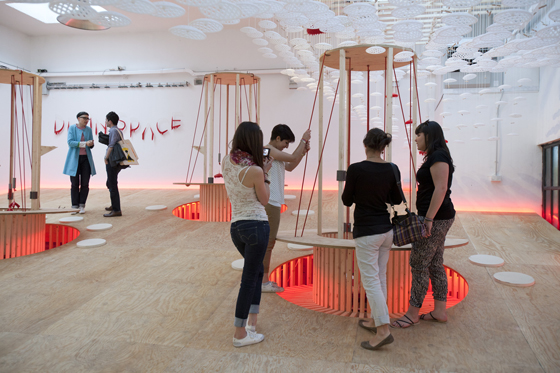
Visitors to 'Dip in Space' were invited to suspend a wax module from the ceiling, having first coated it in red wax, producing a transformation of the space over time in terms of colour and density
×I met up with crasset in Milan during this year's Salone del Mobile, where design graduates from Geneva's Haute Ecole d'Art et de Design (HEAD) were presenting an installation entitled 'Dip in Space', the result of a workshop collaboration between the school and the French designer. Unsurprisingly, the project was strong on concept and process, with not a piece of finished furniture in sight. Having 'dipped', as requested (visitors were asked, one by one, to coat a wax element in red wax by lowering into vat, and then to suspend their contribution on a thin wire from the ceiling), I sat down with crasset on the space's sloping floor (no furniture, remember) to discuss the rationale for the installation, its relation to her own ongoing work and why, for her, it's the taking part that counts.
crasset's new 'Dynamic Life' sofa for Campeggi, which invites users to reconfigure it continually, becoming active participants in its use and meaning

crasset's new 'Dynamic Life' sofa for Campeggi, which invites users to reconfigure it continually, becoming active participants in its use and meaning
×....
What's the concept behind the HEAD installation here in Milan?
The concept is to create an evolving space. The idea was how to show process. So, the students are learning how to qualify space. It's very relevant to create such a space here in Milan, to invite visitors to experiment, to create their own shapes that will change the space little by little. It moves slowly from white to red, as the modules are covered with red wax.
The concept came out of workshops that I ran with the students. Every element – how you sit in the space, the name, the graphics, the videos – was then developed by small teams. It was very collaborative, which, for me, design is about this, rather than just creating another piece of furniture.
'I started 20 years to try to bring more. Not just to make a object that has just one function... It's a way to have fewer projects, but more generosity': crasset's 'Double Side' chair/desk for Danese, launched at this year's Milan Furniture Fair
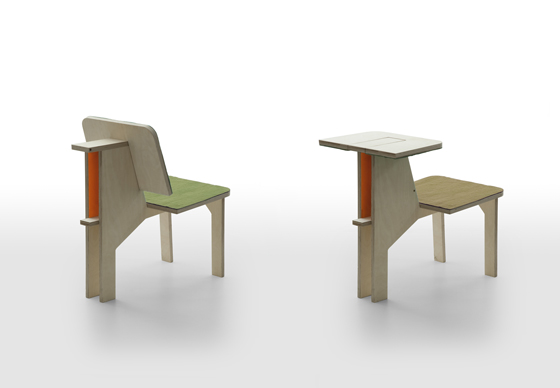
'I started 20 years to try to bring more. Not just to make a object that has just one function... It's a way to have fewer projects, but more generosity': crasset's 'Double Side' chair/desk for Danese, launched at this year's Milan Furniture Fair
×This is interesting, of course, in the context of Milan, where, as the name of the fair would suggest – the Milan Furniture Fair – the focus is on finished products displayed in an almost reverential way...
It's about how a school presents itself in Milan. I had a long discussion with the students about how they wanted to appear as a school. At the start, it was 'We don't want to do this and we don't want to do that', and so on. Then, at the end, we realised we had to do something manifesto-like. We found a way to select one direction, to have a path for everyone to follow and develop this together. It's an important and interesting way of working. The students tested hundreds of different shapes for the modules. The school became a laboratory. A wax laboratory. They had to take something and become experts in it as a group. This was a very interesting process for a school.
It was quite hard, in a way, to find a common direction. But, once you've found your methodology, everybody can follow the same path. I wanted to show them that, with a methodology, you can end up with something very clear at the end, very coherent.
The 'HI matic' hotel in Paris, designed by matali crasset in collaboration with Patrick Elouarghi and Philippe Chatelet, where the cabin-like rooms feature bespoke, multifunctional furniture systems; photo Simon Bouisson
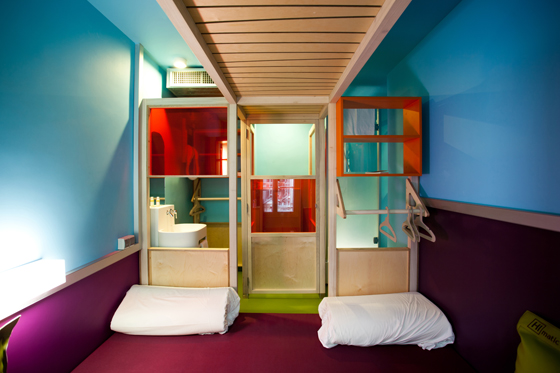
The 'HI matic' hotel in Paris, designed by matali crasset in collaboration with Patrick Elouarghi and Philippe Chatelet, where the cabin-like rooms feature bespoke, multifunctional furniture systems; photo Simon Bouisson
×What does working on projects like this with students teach you yourself? What do you learn?
Well, I learnt that I really like to work with schools, but more in workshop process. Sometimes you have delays. Schools can be complex, due to administration. What I really like is giving a brief to students. Being a designer for me is just that. The possibility to create micro utopias. The idea of pleasure in doing something together. And it was interesting when the project came little by little into reality. They were happy to see the results. To see all the pieces come together.
I like also the idea of showing optimism. When you come to Milan, you see so much stuff. For a young designer, you ask yourself 'What should I do next?' Everything is already there. It's been done already. So I think it's quite nice for young designers to be able to see that they could do something completely different. And a real participation.
Participation is central to the 'HI matic' concept, as guests are invited via a number of screens throughout the building to exchange information and tips on the city

Participation is central to the 'HI matic' concept, as guests are invited via a number of screens throughout the building to exchange information and tips on the city
×I see a real connection between presenting a project like this that is about process within space and your own work. You used the term 'micro utopias' just now. It puts me in mind of your 'Open Room No. 1' scheme that you created for Established & Sons, which defines architectural space through furniture. Presence is created from absence, as your mind continues the work's planes to mark out a contextual space much larger than the sum of the piece's physical parts. This is anything but a static product. It's more of a narrative.
Sure. We don't know what's going on there completely and, of course, it's a proposal. But let's take pleasure in doing things. I mean, we live in a time of crisis and everyone is looking to each other. So the idea is Milan could be a time to take pleasure, to meet people, to participate. Not just looking at something, but doing, acting.
Look at Bruno Munari. He was a designer, but he was also always doing. For me, the role of the designer is also to give a kind of place to experimentation: it could be kids, but also adults. It's part of our job, I think.
'Open Room No. 1' for Established & Sons, where the configuration of a small number of furniture elements serve to define architectural space
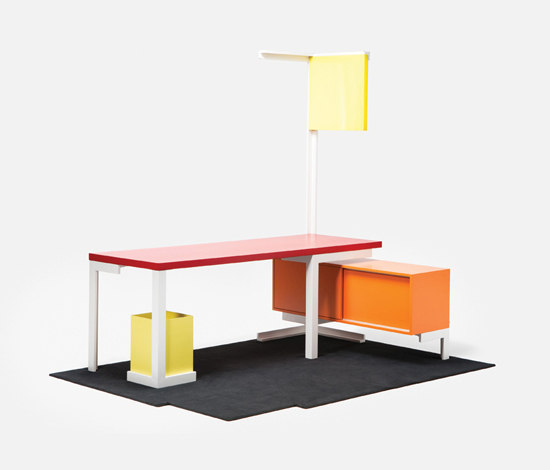
'Open Room No. 1' for Established & Sons, where the configuration of a small number of furniture elements serve to define architectural space
×And I think you do that very well in the work that you create that's produced commercially, like your 'Double Side' chair for Danese or the 'Dynamic Life' sofa for Campeggi, both of which are being shown here in Milan this year. These are finished products that show process, which encourage their users to experiment with them.
Well, they are always evolving because life is like that. Life has nothing to do with fixed images.
I wondered whether you think design work affects behaviour, affects the way we act, or is it a case of your work responding to what you've already recognised in a changing society.
My products are like proposals. If you feel like being active, like interacting with your surroundings. Not like being in a bourgeois position, where you stay like that because you have to play a role. So you can work in a different way. I like to propose scenarios for living. I don't care about products or about space in themselves. Products and space have the potential to bring relief in life. That's why I'm a designer. It's not because I like doing products.
One of crasset's 'micro utopias': the 'dar HI' hotel in Nefta, Tunisia, where each bedroom is situated in a separate tower and the resort is laid out like a self-contained village; photo Jérôme Spriet
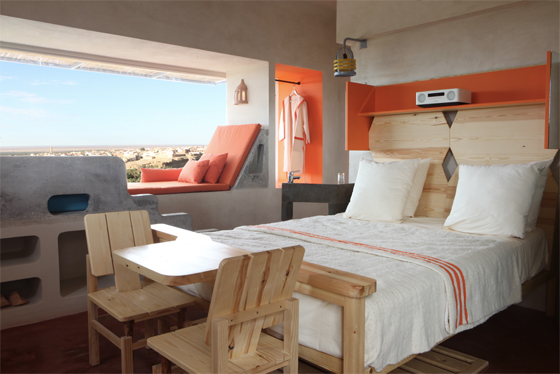
One of crasset's 'micro utopias': the 'dar HI' hotel in Nefta, Tunisia, where each bedroom is situated in a separate tower and the resort is laid out like a self-contained village; photo Jérôme Spriet
×Do you think we are controlled too much by archetypes?
Yes. I like to work a lot with this. 'A chair has to look like a chair.' We have a range of archetypes, but life has nothing to do with this. We learn to eat like this or sleep like that. But what about the interstices? Where are they? This is where life is. This is where it's interesting. So that's why I started 20 years to try to bring more. Not just to make a object that has just one function, which is, of course, what people expect from designers. But I had a feeling that it wasn't enough. So it's also a way to have fewer projects, but more generosity. It's a different attitude towards life. And design is about that.
The kitchen at the 'dar HI' hotel in Nefta, Tunisia; photo Jérôme Spriet
Why do you think there's so much resistance to letting go of those archetypes? Who's maintaining and controlling them ultimately? Is it manufacturing? Or is it we, as consumers, who reinforce them?
Well, when I was a young designer, I thought it was marvellous to be able to do very industrial products. Products that would sell. Now, I feel different. I think you can give more to one person with just one product, and to make this person happy with just this product. A more engaged type of product. I'm working for the curious person. People who want to live in the today. Not in the past. Nothing to do with nostalgia. It's about people who really want to take part. Active people, who aren't just playing a role in life. That's all. It's another kind of attitude.
....







